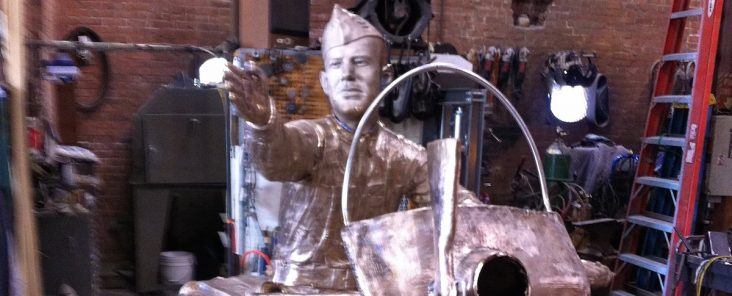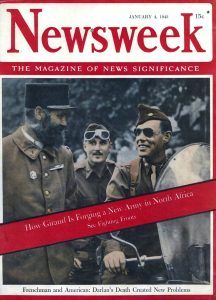Gen. Darby statue ready for placement in Cisterna Plaza in downtown Fort Smith
by April 20, 2016 12:10 pm 828 views

The unfinished General Darby statue crafted by Little Rock-based sculptor and artist Kevin Kresse.
On April 23, 1945, during the waning days of World War II, Colonel William Orlando Darby found himself with an unexpected mission. Robinson E. Duff, the Brigadier General and assistant commander of the U.S. 10th Mountain Division, was wounded in an enemy attack leaving it to the already-highly decorated Darby to take over and lead his “Task Force Darby” to the Po River valley bridgehead in Italy.
The ensuing offensive decimated German forces and led to their eventual retreat. But while conferring with his men one week after assuming command, Darby was one of two killed by an 88mm enemy shell that burst into the middle of the assembled officers and non-commissioned officers (NCOs). Several others were injured.
Task Force Darby continued on with the mission, and two days later, all German forces in Italy surrendered.
The Colonel was posthumously promoted to Brigadier General just 15 days after his death and was buried in Cisterna, Italy, Fort Smith’s sister city. Four years later, the body was exhumed and reinterred at Fort Smith National Cemetery.
General Darby is credited with creating, organizing, and leading the first corps of Army Rangers – called “Darby’s Rangers,” and immortalized in a film of the same name starring James Garner as Darby. He was also known for riding a motorcycle during his service in Europe.

Today his medals are on display at the Fort Smith Museum of History, and his boyhood home remains open for viewing. However, to date there has not been an official monument erected in his honor.
On April 30, that will change.
HONORING A LEGEND
Liz Armstrong and husband Joe, a retired Ranger himself, led an effort to get funding for the 2,500-pound monument that will go on display in Cisterna Park at a 10 a.m. unveiling ceremony on the 71st anniversary of General Darby’s death.
The monument depicts Darby on a motorcycle and gesturing a “forward” signal with his right arm.
Guest speakers will include Dr. Darren McKinney, current principal of Darby Junior High School and chairman of the Darby Legacy Project; Major General William Wofford, a retired adjutant general with the Arkansas National Guard, who along with his son was a fellow Ranger; and Darby Watkins, the nephew of General Darby, who is also the family’s historian and son of General Darby’s younger sister, who was born in 1928 when the General was just 17 years old.
“We may have a World War II Ranger (that served with Darby), health permitting, who will be in attendance,” Armstrong added. “General Darby died 71 years ago, so there may be a few living that still remember him, but they are dying quickly.”
To highlight that point, Armstrong said that three of the bricks in the monument were purchased by family and friends of other Rangers who served with Darby and were still living at the time the effort was launched three years ago, but those men have since died.
Coinciding with and supporting the Darby statue unveiling is the second annual Steel Horse Rally, which is expected to draw tens of thousands of motorcycle riders and enthusiasts to downtown Fort Smith. The rally is geared toward honoring members of the military, veterans, police and firefighters and first responders and has provided funding to the Darby Legacy Project. Other local charities supported by the rally are the Gregory Kistler Treatment Center, The Arkansas Veterans Home, and The Fort Smith Museum of History. Charities supported with proceeds from the 2016 Steel Horse Rally are the Children’s Emergency Shelter-Independent Living Program, Earthbound Angels, Fort Smith Museum of History, Hannah House, and the Gregory Kistler Treatment Center
The Fort Smith Museum of History is also part of the weekend event. Museum staff have updated exhibits in the Darby Memorial Room of the museum located 320 Rogers Ave. in downtown Fort Smith. A cell phone audio tour will feature Presson and Darby Watkins, nephews of General Darby, to include the story of the Fort Smith native and famous founder of Darby’s Rangers in WWII.
The updated exhibition includes Darby’s his early life in Fort Smith and education at West Point, his years as a soldier and the lasting legacy of the well-known founder of the modern Army Rangers.
THE DARBY LEGACY PROJECT
The genesis of the project started in May 2012 with the unveiling of the Bass Reeves Monument. Armstrong and her husband began to wonder why something similar hadn’t happened with one of Fort Smith’s favorite sons and its most decorated war hero.
“The Bass Reeves monument spurred us along, though we had thought about doing it for quite some time,” Armstrong said. “Once it got going, a lot of people got on board and started saying it was one of those things that needed to be done. I think it definitely complements the west end of the (Garrison) Avenue.”
The Darby Legacy Project put out “a call to artists request for bids three years ago,” Armstrong said, and then met with six separate artists to discuss ideas. The group eventually selected Little Rock-based sculptor and artist Kevin Kresse. The last payment has been made, and the total cost was around $250,000, Armstrong said.
“It’s finished, and it will be escorted to Fort Smith by law enforcement, Rangers, and drivers, from Norman, Oklahoma, across the Garrison Avenue Bridge Tuesday the 26th, where it will stop at Cisterna Park for a short photo-op. Then it will go briefly into storage overnight for security purposes, and the mounting process will begin around 10 a.m. on the 27th. That will take a couple of hours.”
In addition to the 1.25-ton weight, the monument, which consists of the General on his motorcycle, will be around 11 feet long (from handlebars to tail) and General Darby on the bike will measure eight feet in height.
The Darby Legacy Project secured most of its funding through individual and business donations made to non-profit organization Park Partners, which was specifically created to help Fort Smith citizens and groups attain funding for park improvement projects like this one without having to go through the 501(c)(3) filing process.
“We’ve had some very generous donations from local businesses from Fort Smith and around the U.S. What I’m most proud of is that most came from individuals, the bulk of whom were from Fort Smith, or Rangers, or West Pointers,” Armstrong said.
One smaller but meaningful part of the funding mechanism was the sale of individualized bricks to be included as part of the monument. The initial run of 500 represented the original volunteers for Darby’s Rangers program and sold for $75 each, a price chosen, Armstrong said, to pay honor to the 75th Ranger Regiment.
